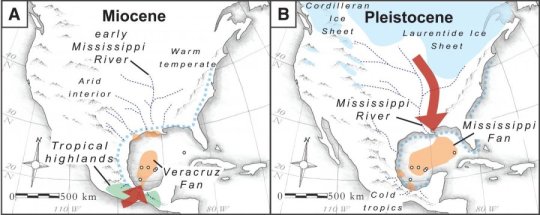[ad_1]
The onset of the most recent ice age about 2.6 million years ago changed where the western Gulf of Mexico gets its supply of sediments. The finding adds new insight into how extreme climate change can directly impact fundamental geological processes and how those impacts play out across different environments.
The research found that the same climatic changes that grew glaciers across the northern hemisphere reduced sediment production in southern Mexico while ramping up sediment production along the catchment of the Mississippi River.
The study was previously made available online on October 8, 2018 ahead of final publication in print on Nov.1, 2018, in the journal Geology. Angela Hessler, the director of the Deep Time Institute, led the research. It was co-authored by Jacob Covault, a research scientist at the University of Texas at Austin Bureau of Economic Geology; Daniel Stockli, a professor in the Department of Geological Sciences at the UT Jackson School of Geosciences; and Andrea Fildani, a scientist at the Equinor Research Center Austin.
The Bureau of Economic Geology is a research unit of the Jackson School.
The Gulf of Mexico has been catching sediments transported by rivers for about 200 million years. The layers of sediments that accumulate on the seafloor record information about the origin of the sediments and the erosive processes that lifted them from the rock. In this study, the scientists examined sediments deposited during the 20-million-year transition from the Miocene to the Pleistocene, when the Earth’s climate transitioned from a relatively warm period to an ice age.
“It’s an important transition climate-wise,” said Hessler. “Climate cycles changed, and it’s possible that changed the erodibility and the transport mechanism across North America to be able to shed all this material out toward Mexico.”
Based on the composition of the sediments, the researchers were able to determine that the primary supply of sediments during the middle-to-late Miocene came from rivers in southern Mexico. This came as a surprise because of the rivers’ relatively small catchment — an area in the tropical highlands of Mexico about 300-by-500-square kilometers, or about the size of Illinois. However, the sediments revealed that what the area lacked in size it made up for with highly erodible conditions, including a wet climate and tectonic activity such as uplifting mountains and volcanoes.
But that environment changed with the global cooling of the Pleistocene. The highlands became dry and arid. And while tectonic activity still continued, the lack of precipitation meant that the fresh bedrock and volcanic debris largely stayed in place. In what is now the United States, large ice sheets started to form and erode rock as they flowed across the continent.
The study found that this extreme climate shift is reflected by a change in sediments. By the mid-Pleistocene, almost all the sediments in the Gulf of Mexico came from the north via the Mississippi River, which collected sediments from waterways across the continent.
The study was able to unpack so much about the age, origin and environment of the sediments because of thorough research methods that examined the mud created by the sediments along with the grains, said Stockli.
“One of the really cool things about this paper is that there haven’t been that many studies that actually combine the two records,” he said. “People traditionally don’t do that much with the muck, but that clay tells us so much about the weathering, and what those conditions are.”
The methods used by the scientists included, microscope observations of sand grains, geochemical analyses of trace elements in sediment muds using mass spectrometry, and zircon U-Pb isotope analyses. The sediments themselves came from five core samples that were retrieved from across the Gulf of Mexico by the Deep Sea Drilling Project, the precursor to the International Ocean Discovery Program, about 50 years ago.
Studying how the Earth’s climate impacts sediment transport helps researchers understand the connection between climate change and other geological processes. This connection could be an important point to consider when predicting the future impacts of climate change on the rest of the natural world.
“All this information about provenance, and how things interacted at one time or another, or climate — it’s all contained in this stratigraphic archive,” said Covault. “It just takes a couple people to interrogate the heck out of it and put together a really interesting story that has implications beyond the Gulf of Mexico, for other places that might be subjected to climate change.”
The research was funded by the Jackson School of Geosciences and the Equinor Research Center Austin.
[ad_2]















